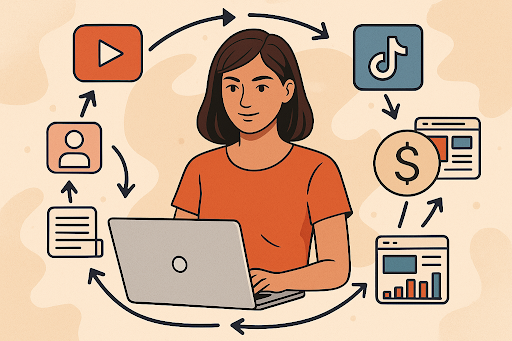Introduction: Unlocking Hidden Value in Digital Assets
Have you ever purchased something for pocket change that ended up being worth thousands? For Mark Winters, a graphic designer from Portland, this isn’t just a dream scenario—it’s his monthly reality. With just a $12 initial investment and a clever approach to micro-licensing, Mark transformed a simple digital asset into a passive income stream generating $2,700 every month.
In today’s digital economy, micro-licensing has emerged as one of the most overlooked yet powerful passive income strategies. Unlike traditional business models that require significant capital or time investments, micro-licensing allows creators to monetize their work repeatedly with minimal ongoing effort.
In this guide, you’ll discover exactly how micro-licensing works, how to identify digital assets with high licensing potential, and the step-by-step strategy that successful entrepreneurs are using to build substantial passive income in 2025.
What Are Micro-Licenses and Why They’re Digital Gold Mines
Micro-licensing refers to the practice of creating and selling limited-use licenses for digital assets at affordable price points. Unlike exclusive licensing that typically involves higher fees for limited clients, micro-licensing works on a volume model—selling many licenses at lower price points to a wider audience.
The beauty of this approach lies in its scalability. Once you’ve created your digital asset, whether it’s a template, plugin, graphic, or piece of code, the same product can be licensed thousands of times with zero additional production costs.
Types of Digital Assets Perfect for Micro-Licensing in 2025
✅ Software components and code snippets: Custom WordPress plugins, JavaScript libraries, or API integrations
✅ Design elements: Logo templates, icon sets, UI kits, or website themes
✅ Audio assets: Sound effects, jingles, voice overs, or royalty-free music
✅ Written content: Templates, frameworks, scripts, or specialized formulas
✅ Photography: Stock photos, photo presets, or specialized image collections
The key advantage of micro-licensing is that unlike selling a product outright, you maintain ownership of your intellectual property while granting others limited rights to use it—creating a continuous income stream rather than a one-time sale.
SPOTLIGHT: [The $9 ‘Micro-Course’ Strategy That’s Creating $3,200 Monthly for People With No Teaching Experience]
Case Study: Mark’s $12 to $2,700 Monthly Passive Income Journey
Mark Winters’ success story begins with a problem he faced as a graphic designer. While working on client websites, he repeatedly needed to create custom checkout page templates that were both conversion-optimized and compatible with various e-commerce platforms.
“I kept building the same types of checkout pages for different clients,” Mark explains. “I realized if I was having this problem, thousands of other designers and business owners probably were too.”
The Initial $12 Investment Breakdown
Mark’s investment was surprisingly modest:
- $9 for a commercial font license that gave him redistribution rights
- $3 for a specialized plugin that helped him create modular code
With these tools, he developed a set of 15 customizable checkout page templates optimized for conversions across multiple e-commerce platforms.
The Strategic Micro-Licensing Model
Rather than selling his templates outright, Mark opted for a micro-licensing approach with three key elements:
- Tiered licensing structure:
- Basic License: $27 (use on one website)
- Extended License: $47 (use on up to 5 websites)
- Developer License: $97 (use on unlimited client projects)
- Distribution platforms: Instead of relying solely on his own website, Mark listed his templates on specialized marketplaces like ThemeForest, Creative Market, and Gumroad, leveraging their existing traffic.
- Strategic pricing psychology: By pricing just below common threshold points ($27 instead of $30), Mark made his offerings seem more accessible while maintaining healthy margins.
The Income Progression Timeline
Mark’s journey from $12 investment to $2,700 monthly income didn’t happen overnight:
- Month 1: 12 sales generating $324
- Month 3: 38 sales generating $1,026
- Month 6: 76 sales generating $2,052
- Month 12: 100+ monthly sales generating $2,700+
“What surprised me most wasn’t just the money, but how truly passive it became,” Mark notes. “After the initial creation and some minor updates every few months, the income continues with almost no additional work.”
How to Identify High-Potential Micro-License Opportunities
The most critical step in replicating Mark’s success is identifying the right opportunity. The most profitable micro-licensing ventures typically share these characteristics:
1. Solves a Specific, Recurring Problem
Look for pain points that:
- Occur repeatedly in professional workflows
- Currently require custom solutions each time
- Affect a sizable market segment
SPOTLIGHT: [The 9-Day ‘Subscriber Acceleration’ Formula That’s Building $3,600 Monthly Passive Income Streams]
2. Requires Specialized Expertise to Create
The best micro-licensing opportunities involve assets that:
- Require knowledge most people don’t have
- Combine multiple skill sets (e.g., design + coding)
- Save substantial time for the end user
3. Has Clear Commercial Application
Successful micro-licensed products typically:
- Directly help users make or save money
- Integrate with existing popular platforms
- Enhance professional output quality
Building Your Micro-License System: A 5-Step Blueprint
Ready to build your own micro-licensing business? Follow this systematic approach that has worked for dozens of successful digital entrepreneurs in 2025:
Step 1: Market Research and Validation
Before creating anything, validate your concept by:
✅ Researching existing marketplace offerings and identifying gaps
✅ Analyzing competitor pricing and licensing structures
✅ Gathering feedback through online communities related to your niche
✅ Testing demand with a pre-launch landing page
Don’t skip this critical step. According to recent data from DigitalAssetTrends.com, creators who conduct thorough market research earn 3.7x more than those who skip validation.
Step 2: Asset Creation and Packaging
Once validated, focus on creating an exceptional asset:
✅ Prioritize quality over quantity initially
✅ Create comprehensive documentation
✅ Develop a clear value proposition that highlights time/money saved
✅ Bundle complementary elements to increase perceived value
“The key is creating something so useful that buying it becomes a no-brainer compared to the time it would take to create it from scratch,” explains digital product expert Sarah Chen.
Step 3: Licensing Structure Development
Design a licensing framework that:
✅ Protects your intellectual property rights
✅ Offers clear value at each pricing tier
✅ Includes strategic upsells and bundle options
✅ Aligns with industry standards while remaining simple to understand
In 2025, the most successful creators typically offer 3-4 license tiers with permission boundaries based on usage scope rather than time limitations.
Step 4: Distribution Strategy
Maximize your reach through:
✅ Specialized digital marketplaces relevant to your asset type
✅ Your own website (with proper SEO optimization)
✅ Strategic partnerships with complementary service providers
✅ Content marketing that demonstrates your asset’s value
According to recent marketplace data, products listed on multiple platforms typically see 2.3x more revenue than single-platform listings.
Step 5: Optimization and Scaling
Once your system is running:
✅ Gather and implement user feedback
✅ Create additional assets that complement your existing offerings
✅ Test price points and bundle options
✅ Develop automated marketing sequences
The real power of micro-licensing emerges when you build a portfolio of digital assets that generate income simultaneously.
Common Pitfalls to Avoid in Micro-Licensing
Even with a solid strategy, certain mistakes can derail your micro-licensing success:
Legal and Rights Management Issues
Many creators underestimate the importance of:
- Properly documenting third-party asset usage rights
- Creating clear license terms and limitations
- Understanding marketplace policies regarding intellectual property
“I’ve seen promising businesses collapse due to licensing disputes that could have been avoided with proper documentation,” warns intellectual property attorney Maria Lopez.
Underpricing Your Value
First-time creators often:
- Price based on creation time rather than value delivered
- Fail to account for support and maintenance costs
- Underestimate their specialized expertise
According to pricing experts, digital assets are typically underpriced by 40-60% when creators first enter the market.
Neglecting Marketing Fundamentals
Even exceptional assets can fail without:
- Clear benefit articulation in product descriptions
- High-quality preview materials and demonstrations
- Strategic keyword optimization for marketplace search algorithms
Your Action Plan: Next Steps to Launch Your Micro-Licensing Business
Ready to create your own micro-licensing success story? Here’s what to do next:
- Identify your expertise area: What specialized skills or knowledge do you possess that others would pay to access?
- List 5 potential micro-license assets: Brainstorm digital products that leverage your expertise and solve specific problems.
- Validate your top concept: Research marketplaces, analyze competition, and gauge interest in online communities.
- Create your minimum viable product: Develop a high-quality initial version that delivers clear value.
- Set up your licensing structure: Create clear terms and tiered pricing based on usage scope.
The digital economy continues to reward those who can solve specific problems with scalable solutions. With micro-licensing, your specialized knowledge becomes not just a service you sell once, but an asset that generates income month after month.
As Mark Winters puts it: “The most powerful shift in my financial life wasn’t earning more per hour—it was disconnecting my income from my time entirely.”
Ready to transform your knowledge into passive income? The micro-licensing opportunity has never been more accessible than it is today in 2025.
External Reference: According to the Digital Asset Market Report 2025 by MarketWatch Research, the market for micro-licensed digital assets is projected to reach $17.8 billion by 2027, growing at 24% annually.









